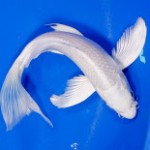Ogon (meaning “golden”) koi are metallic, solid, single-colored koi fish in the Hikarimuji class (Hikari – “shiny”; Muji – “one”). Ogon has become synonymous with a collective name for metallic, solid-colored koi. An Ogon’s brilliant luster makes it immediately recognizable—especially in murkier ponds—and its graceful simplicity is a lovely contrast to the multi-colored varieties.
Because of their basic colors, Ogon often earn the reputation of being a beginner’s koi. However, Ogon remain a popular choice and will grace both beginning and seasoned ponds alike. A flawless, high-quality Ogon is often a welcome addition to a veteran enthusiast.
Ogon koi have been around since the mid-1940s, and were named for the original gold-colored koi produced by the Aoki family in Japan. They have healthy appetites and grow rapidly (probably as a result!).
As a complement to their love for food, they are also quite friendly—which makes hand feeding easier. Having them in your pond is a good way to encourage shier koi to hand feed. Given the proper care, Ogon koi can live a long life, sometimes upwards of 35 years.
Being metallic and monochromatic, it is easier to spot imperfections in Ogon. Poor scalation and scars (or other types of blemishes) will be immediately recognizable. Some of the things that you will need to look for in a good quality Ogon are:
- clear head (no discoloration)
- uniform body color
- brilliant luster or sheen
- scales in perfect alignment
- shiny and “unstriped” (transparent edged) fins
- body free of scars
As they age, the skin in adult Ogon will start to emerge between the scales to give a reticulated, netting effect known as fukurin (FOO-koo-reen). The contrast between skin and scales is considered highly attractive and prized among veteran koi enthusiasts.
There are numerous varieties of Ogon koi, but the three most popular types are the Platinum, Yamabuki and Orenji.
Platinum Ogon

Known as Purachina (poo-RAH-chee-nah) Ogon in Japan, this metallic, all-white koi is one of the most sought after. It is important that the white coloring be uniform. Any scars or other blemishes also make it less desirable.
There is a “duller” pale gold (or cream-colored) Platinum Ogon, but it is more difficult to find.
Yamabuki (YAH-mah-BOO-kee) Ogon

This is a metallic yellow koi. The colors can range from a deep gold to a lighter, more vibrant yellow.
The pectoral fins can have some yellow at the base that fans out across the fin, but ideally, they should be white.
Orenji (oh-REHN-gee) Ogon

This is the metallic orange Ogon variety. Similar to the Yamabuki, the fins should be white, but orange can spread out from the fin’s base.
Nezu (NEH-zoo) Ogon
A silvery-gray koi that is considered an older type of Ogon.
Other Varieties
There are other colorations of Ogon koi available too.
- Hi (Hee) Ogon
This is a metallic red colored Ogon.
- Mukashi (MOO-kah-SHEE) Ogon
A lesser-known variety, it is bronze colored.
- Kuro (KOO-roh) Ogon
A metallic black Ogon.
Selective cross breeding has resulted in new varieties of Ogon, the major one being Matsuba (maht-SOO-bah) Ogon. It is a metallic koi, whose base is a single color overlaid with a reticulated “pine-cone” pattern of black-centered scales. The black netting is actually considered to be a darker version of the base color.

The body coloration of the Matsuba Ogon mirrors that of the other Ogon types (white, red, orange and yellow). The most prevalent types are: The red Aka (AH-kah) Matsuba, the yellow or gold Ki (KEE) Matsuba, silver or white Gin (GEEN) and orange Orenji Matsuba.
Additionally, there are variations on the scale types that are available, creating a broad selection of Ogon for enthusiasts to choose from. Each of the Ogon types also come in Doitsu (scaleless) and sparkling-scaled Gin Rin (geen deen).
Varieties of butterfly Ogon are also available to enthusiasts who would like to add another dimension to their pond or selection of Ogon Living Jewels.
To stock your pond with an Ogon koi in as little as 24 hours, choose from Next Day Koi’s wide selection of varieties and types of this enthusiast favorite. Sourced from some of the best hatcheries in the industry, Next Day Koi backs that up with some of the most competitive shipping rates in the industry. Contact us to see how we can supply your next Living Jewel.

What a wonderfully clear explanation of Ogon, and I love all your pronunciation guides. Can you please tell me the proper pronunciation of “Ogon” ?
Thank you for the kind words and your feedback, Katherine. The proper pronunciation of Ogon would be “oh-GAHN”.